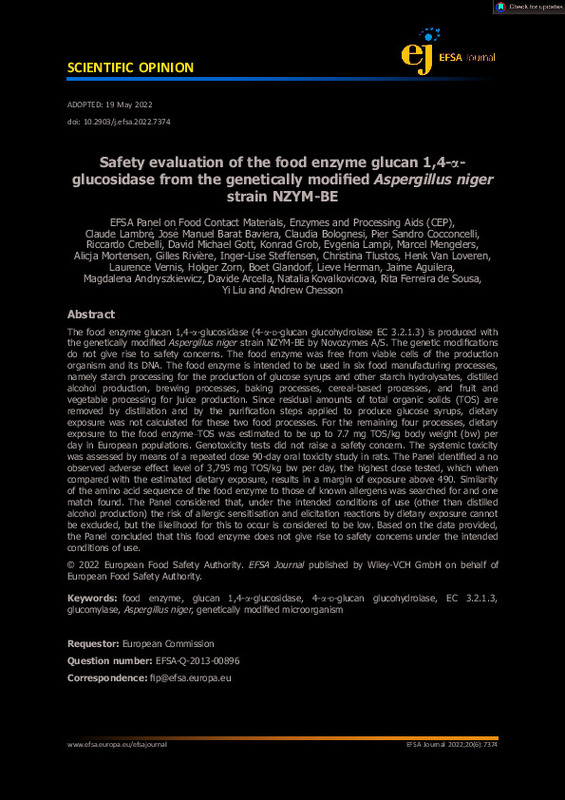|
Resumen:
|
[EN] The food enzyme glucan 1,4-alpha-glucosidase (4-alpha-D-glucan glucohydrolase EC 3.2.1.3) is produced with the genetically modified Aspergillus niger strain NZYM-BE by Novozymes A/S. The genetic modifications do not ...[+]
[EN] The food enzyme glucan 1,4-alpha-glucosidase (4-alpha-D-glucan glucohydrolase EC 3.2.1.3) is produced with the genetically modified Aspergillus niger strain NZYM-BE by Novozymes A/S. The genetic modifications do not give rise to safety concerns. The food enzyme was free from viable cells of the production organism and its DNA. The food enzyme is intended to be used in six food manufacturing processes, namely starch processing for the production of glucose syrups and other starch hydrolysates, distilled alcohol production, brewing processes, baking processes, cereal-based processes, and fruit and vegetable processing for juice production. Since residual amounts of total organic solids (TOS) are removed by distillation and by the purification steps applied to produce glucose syrups, dietary exposure was not calculated for these two food processes. For the remaining four processes, dietary exposure to the food enzyme-TOS was estimated to be up to 7.7 mg TOS/kg body weight (bw) per day in European populations. Genotoxicity tests did not raise a safety concern. The systemic toxicity was assessed by means of a repeated dose 90-day oral toxicity study in rats. The Panel identified a no observed adverse effect level of 3,795 mg TOS/kg bw per day, the highest dose tested, which when compared with the estimated dietary exposure, results in a margin of exposure above 490. Similarity of the amino acid sequence of the food enzyme to those of known allergens was searched for and one match found. The Panel considered that, under the intended conditions of use (other than distilled alcohol production) the risk of allergic sensitisation and elicitation reactions by dietary exposure cannot be excluded, but the likelihood for this to occur is considered to be low. Based on the data provided, the Panel concluded that this food enzyme does not give rise to safety concerns under the intended conditions of use.
[-]
|









